Organisational Culture, Politics, Power and Influence at Hilton Hotel
VerifiedAdded on 2022/09/11
|20
|5381
|21
Report
AI Summary
This report analyzes the influence of culture, politics, and power on employee motivation and organizational success at Hilton Hotel, focusing on the application of various motivational theories. It examines how Hilton's culture of treating all employees equally, from executives to frontline staff, fosters a positive working environment, boosts morale, and enhances customer experience. The report discusses Herzberg's theory of motivation, highlighting how Hilton addresses both motivators and hygiene factors to increase employee satisfaction and reduce dissatisfaction. Vroom's expectancy theory is also applied, emphasizing how Hilton motivates employees by providing them with the necessary skills and resources to succeed. Furthermore, the report explores the role of emotional intelligence and soft skills in Hilton's management, detailing how managers use self-awareness, self-regulation, and empathy to effectively lead and influence their teams. The report also examines how motivational theories can be used to influence behavior, including Maslow's hierarchy of needs, Herzberg's theory, and Vroom's theory. Finally, the report emphasizes the interconnectedness of culture, politics, power, and motivation, and their combined impact on organisational success, highlighting the importance of a welcoming culture, equitable distribution of power, and employee motivation for achieving organisational goals.
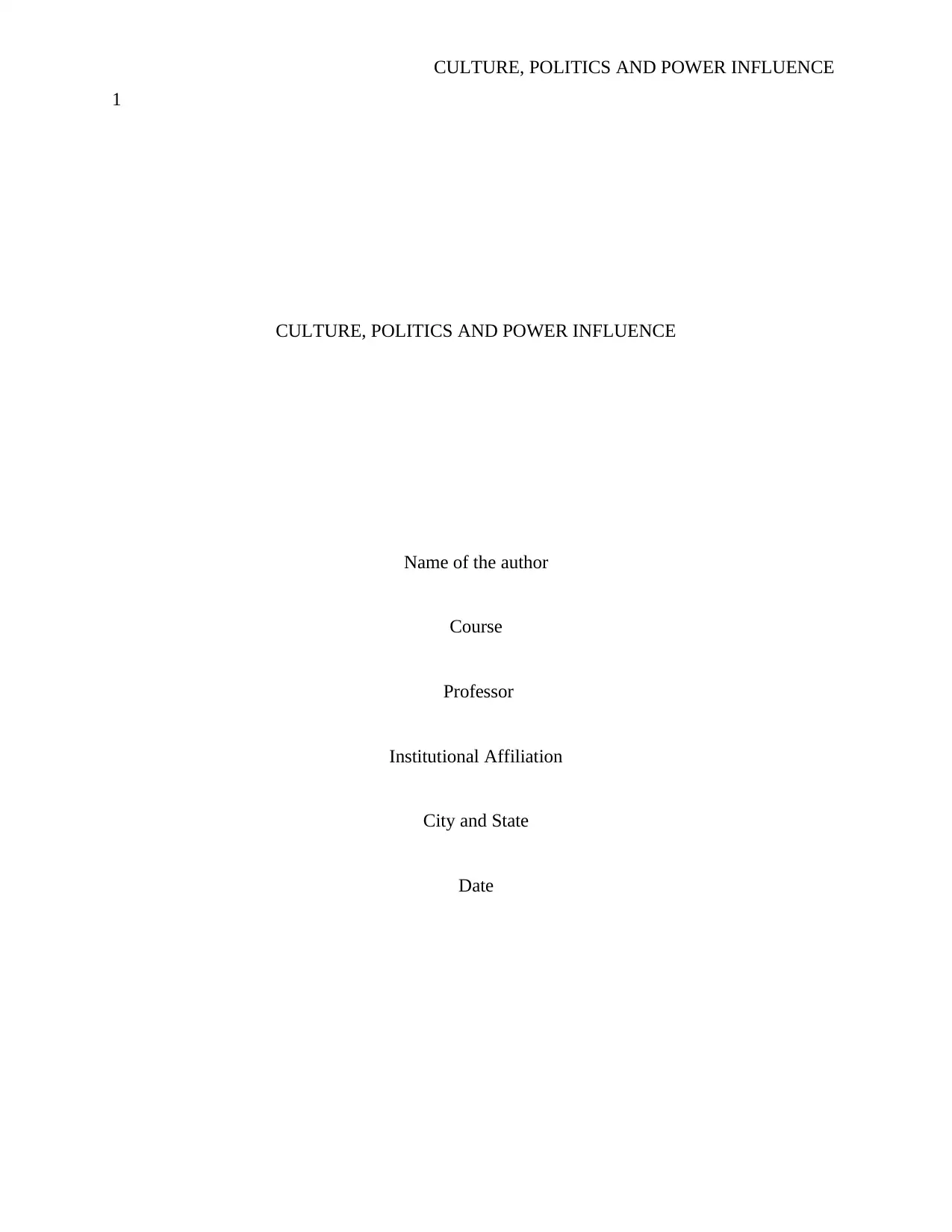
CULTURE, POLITICS AND POWER INFLUENCE
1
CULTURE, POLITICS AND POWER INFLUENCE
Name of the author
Course
Professor
Institutional Affiliation
City and State
Date
1
CULTURE, POLITICS AND POWER INFLUENCE
Name of the author
Course
Professor
Institutional Affiliation
City and State
Date
Paraphrase This Document
Need a fresh take? Get an instant paraphrase of this document with our AI Paraphraser
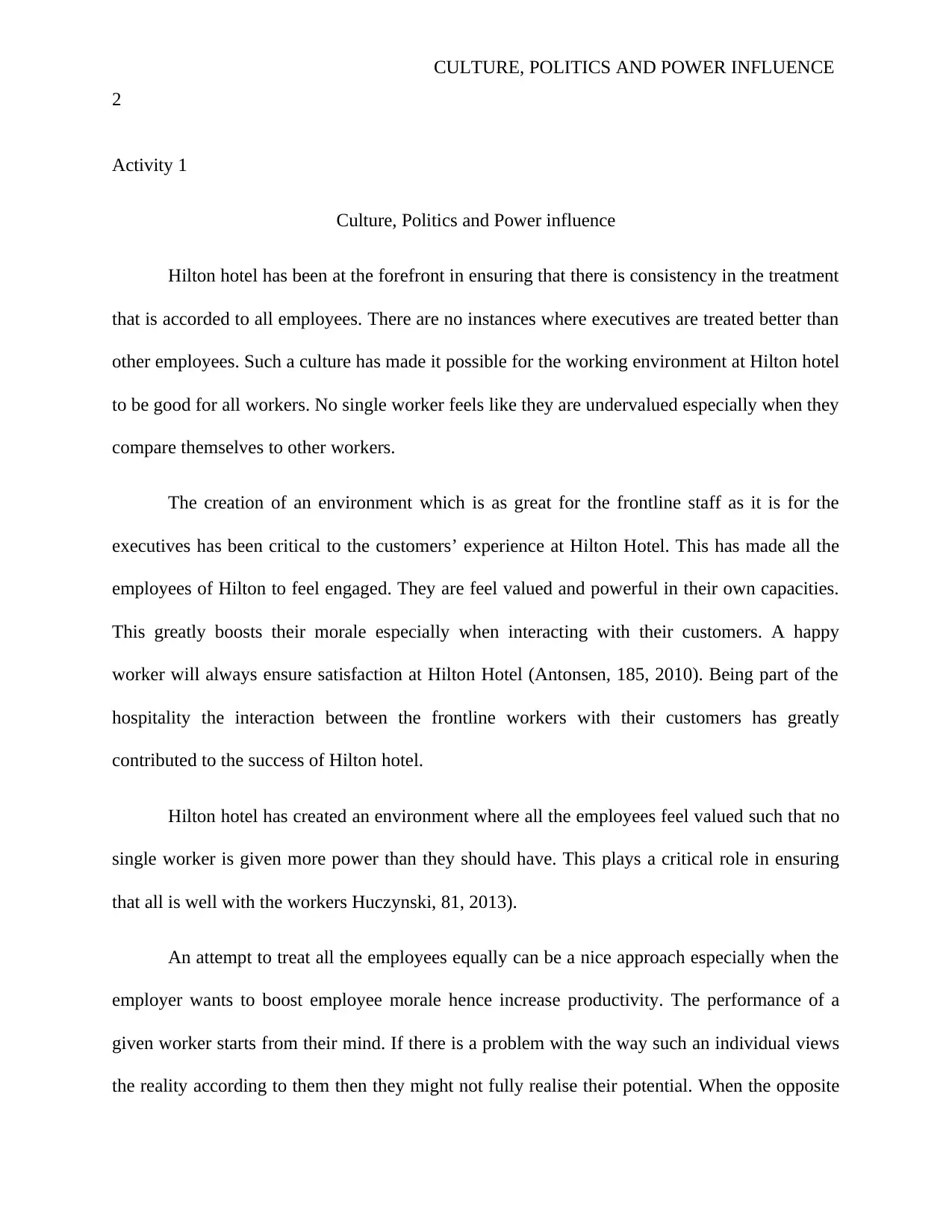
CULTURE, POLITICS AND POWER INFLUENCE
2
Activity 1
Culture, Politics and Power influence
Hilton hotel has been at the forefront in ensuring that there is consistency in the treatment
that is accorded to all employees. There are no instances where executives are treated better than
other employees. Such a culture has made it possible for the working environment at Hilton hotel
to be good for all workers. No single worker feels like they are undervalued especially when they
compare themselves to other workers.
The creation of an environment which is as great for the frontline staff as it is for the
executives has been critical to the customers’ experience at Hilton Hotel. This has made all the
employees of Hilton to feel engaged. They are feel valued and powerful in their own capacities.
This greatly boosts their morale especially when interacting with their customers. A happy
worker will always ensure satisfaction at Hilton Hotel (Antonsen, 185, 2010). Being part of the
hospitality the interaction between the frontline workers with their customers has greatly
contributed to the success of Hilton hotel.
Hilton hotel has created an environment where all the employees feel valued such that no
single worker is given more power than they should have. This plays a critical role in ensuring
that all is well with the workers Huczynski, 81, 2013).
An attempt to treat all the employees equally can be a nice approach especially when the
employer wants to boost employee morale hence increase productivity. The performance of a
given worker starts from their mind. If there is a problem with the way such an individual views
the reality according to them then they might not fully realise their potential. When the opposite
2
Activity 1
Culture, Politics and Power influence
Hilton hotel has been at the forefront in ensuring that there is consistency in the treatment
that is accorded to all employees. There are no instances where executives are treated better than
other employees. Such a culture has made it possible for the working environment at Hilton hotel
to be good for all workers. No single worker feels like they are undervalued especially when they
compare themselves to other workers.
The creation of an environment which is as great for the frontline staff as it is for the
executives has been critical to the customers’ experience at Hilton Hotel. This has made all the
employees of Hilton to feel engaged. They are feel valued and powerful in their own capacities.
This greatly boosts their morale especially when interacting with their customers. A happy
worker will always ensure satisfaction at Hilton Hotel (Antonsen, 185, 2010). Being part of the
hospitality the interaction between the frontline workers with their customers has greatly
contributed to the success of Hilton hotel.
Hilton hotel has created an environment where all the employees feel valued such that no
single worker is given more power than they should have. This plays a critical role in ensuring
that all is well with the workers Huczynski, 81, 2013).
An attempt to treat all the employees equally can be a nice approach especially when the
employer wants to boost employee morale hence increase productivity. The performance of a
given worker starts from their mind. If there is a problem with the way such an individual views
the reality according to them then they might not fully realise their potential. When the opposite
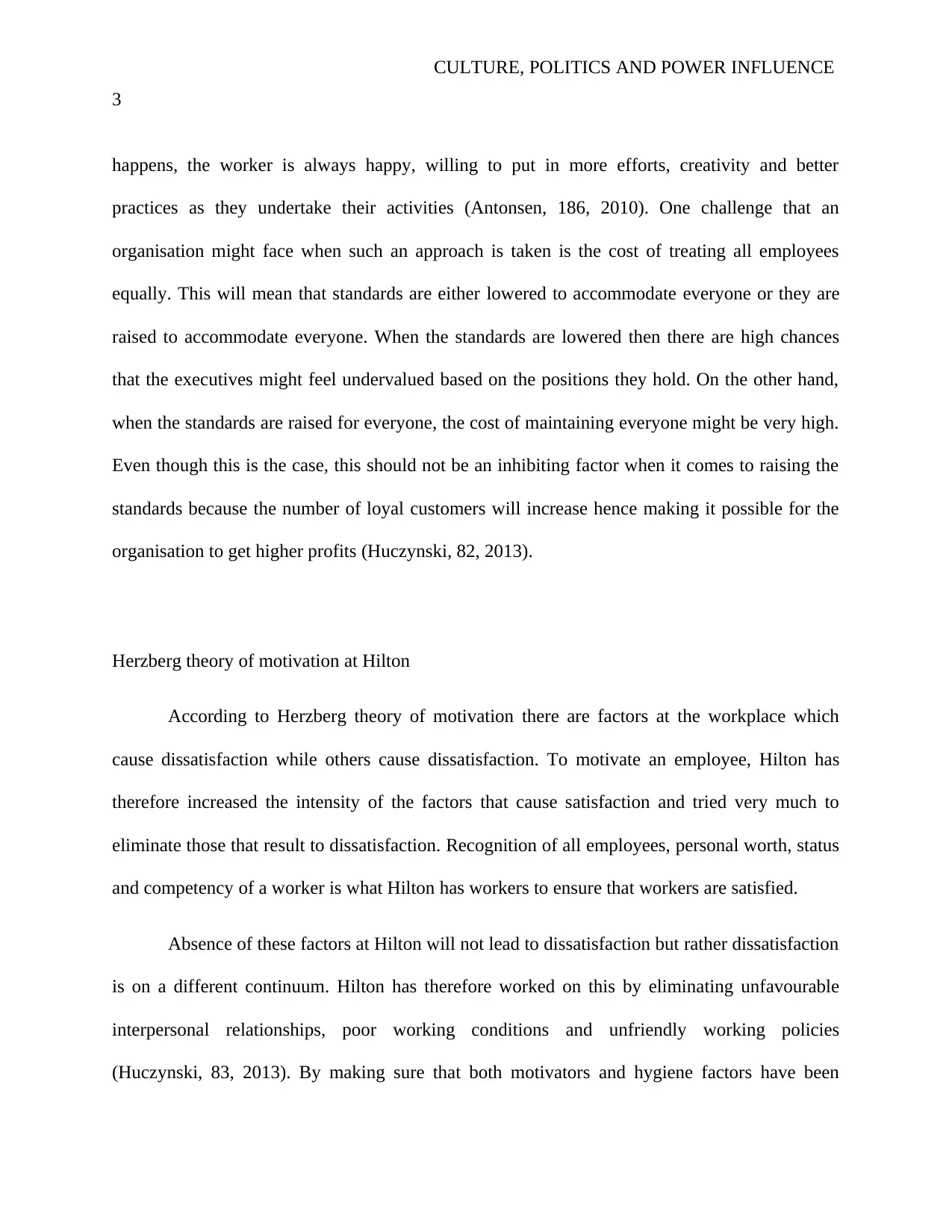
CULTURE, POLITICS AND POWER INFLUENCE
3
happens, the worker is always happy, willing to put in more efforts, creativity and better
practices as they undertake their activities (Antonsen, 186, 2010). One challenge that an
organisation might face when such an approach is taken is the cost of treating all employees
equally. This will mean that standards are either lowered to accommodate everyone or they are
raised to accommodate everyone. When the standards are lowered then there are high chances
that the executives might feel undervalued based on the positions they hold. On the other hand,
when the standards are raised for everyone, the cost of maintaining everyone might be very high.
Even though this is the case, this should not be an inhibiting factor when it comes to raising the
standards because the number of loyal customers will increase hence making it possible for the
organisation to get higher profits (Huczynski, 82, 2013).
Herzberg theory of motivation at Hilton
According to Herzberg theory of motivation there are factors at the workplace which
cause dissatisfaction while others cause dissatisfaction. To motivate an employee, Hilton has
therefore increased the intensity of the factors that cause satisfaction and tried very much to
eliminate those that result to dissatisfaction. Recognition of all employees, personal worth, status
and competency of a worker is what Hilton has workers to ensure that workers are satisfied.
Absence of these factors at Hilton will not lead to dissatisfaction but rather dissatisfaction
is on a different continuum. Hilton has therefore worked on this by eliminating unfavourable
interpersonal relationships, poor working conditions and unfriendly working policies
(Huczynski, 83, 2013). By making sure that both motivators and hygiene factors have been
3
happens, the worker is always happy, willing to put in more efforts, creativity and better
practices as they undertake their activities (Antonsen, 186, 2010). One challenge that an
organisation might face when such an approach is taken is the cost of treating all employees
equally. This will mean that standards are either lowered to accommodate everyone or they are
raised to accommodate everyone. When the standards are lowered then there are high chances
that the executives might feel undervalued based on the positions they hold. On the other hand,
when the standards are raised for everyone, the cost of maintaining everyone might be very high.
Even though this is the case, this should not be an inhibiting factor when it comes to raising the
standards because the number of loyal customers will increase hence making it possible for the
organisation to get higher profits (Huczynski, 82, 2013).
Herzberg theory of motivation at Hilton
According to Herzberg theory of motivation there are factors at the workplace which
cause dissatisfaction while others cause dissatisfaction. To motivate an employee, Hilton has
therefore increased the intensity of the factors that cause satisfaction and tried very much to
eliminate those that result to dissatisfaction. Recognition of all employees, personal worth, status
and competency of a worker is what Hilton has workers to ensure that workers are satisfied.
Absence of these factors at Hilton will not lead to dissatisfaction but rather dissatisfaction
is on a different continuum. Hilton has therefore worked on this by eliminating unfavourable
interpersonal relationships, poor working conditions and unfriendly working policies
(Huczynski, 83, 2013). By making sure that both motivators and hygiene factors have been
⊘ This is a preview!⊘
Do you want full access?
Subscribe today to unlock all pages.

Trusted by 1+ million students worldwide
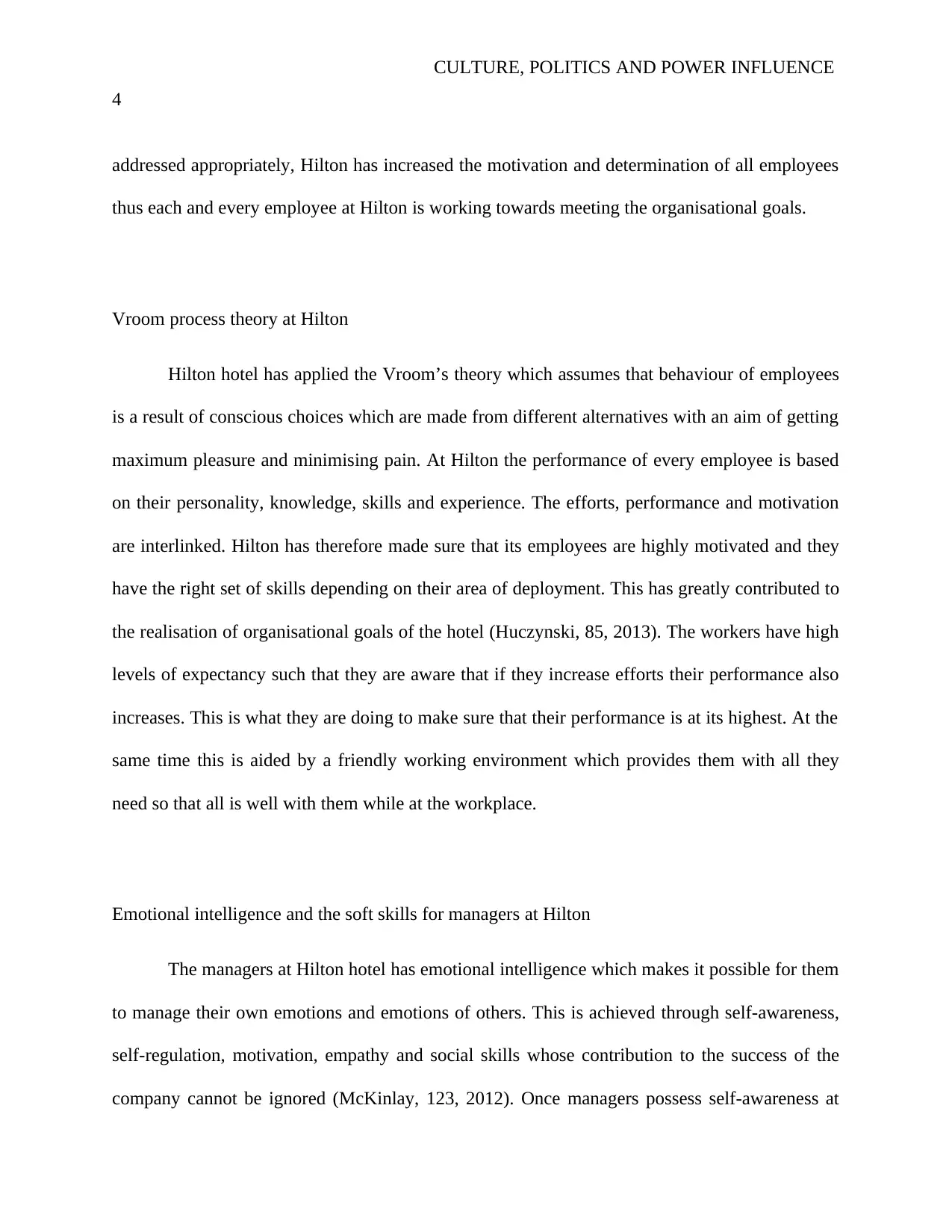
CULTURE, POLITICS AND POWER INFLUENCE
4
addressed appropriately, Hilton has increased the motivation and determination of all employees
thus each and every employee at Hilton is working towards meeting the organisational goals.
Vroom process theory at Hilton
Hilton hotel has applied the Vroom’s theory which assumes that behaviour of employees
is a result of conscious choices which are made from different alternatives with an aim of getting
maximum pleasure and minimising pain. At Hilton the performance of every employee is based
on their personality, knowledge, skills and experience. The efforts, performance and motivation
are interlinked. Hilton has therefore made sure that its employees are highly motivated and they
have the right set of skills depending on their area of deployment. This has greatly contributed to
the realisation of organisational goals of the hotel (Huczynski, 85, 2013). The workers have high
levels of expectancy such that they are aware that if they increase efforts their performance also
increases. This is what they are doing to make sure that their performance is at its highest. At the
same time this is aided by a friendly working environment which provides them with all they
need so that all is well with them while at the workplace.
Emotional intelligence and the soft skills for managers at Hilton
The managers at Hilton hotel has emotional intelligence which makes it possible for them
to manage their own emotions and emotions of others. This is achieved through self-awareness,
self-regulation, motivation, empathy and social skills whose contribution to the success of the
company cannot be ignored (McKinlay, 123, 2012). Once managers possess self-awareness at
4
addressed appropriately, Hilton has increased the motivation and determination of all employees
thus each and every employee at Hilton is working towards meeting the organisational goals.
Vroom process theory at Hilton
Hilton hotel has applied the Vroom’s theory which assumes that behaviour of employees
is a result of conscious choices which are made from different alternatives with an aim of getting
maximum pleasure and minimising pain. At Hilton the performance of every employee is based
on their personality, knowledge, skills and experience. The efforts, performance and motivation
are interlinked. Hilton has therefore made sure that its employees are highly motivated and they
have the right set of skills depending on their area of deployment. This has greatly contributed to
the realisation of organisational goals of the hotel (Huczynski, 85, 2013). The workers have high
levels of expectancy such that they are aware that if they increase efforts their performance also
increases. This is what they are doing to make sure that their performance is at its highest. At the
same time this is aided by a friendly working environment which provides them with all they
need so that all is well with them while at the workplace.
Emotional intelligence and the soft skills for managers at Hilton
The managers at Hilton hotel has emotional intelligence which makes it possible for them
to manage their own emotions and emotions of others. This is achieved through self-awareness,
self-regulation, motivation, empathy and social skills whose contribution to the success of the
company cannot be ignored (McKinlay, 123, 2012). Once managers possess self-awareness at
Paraphrase This Document
Need a fresh take? Get an instant paraphrase of this document with our AI Paraphraser
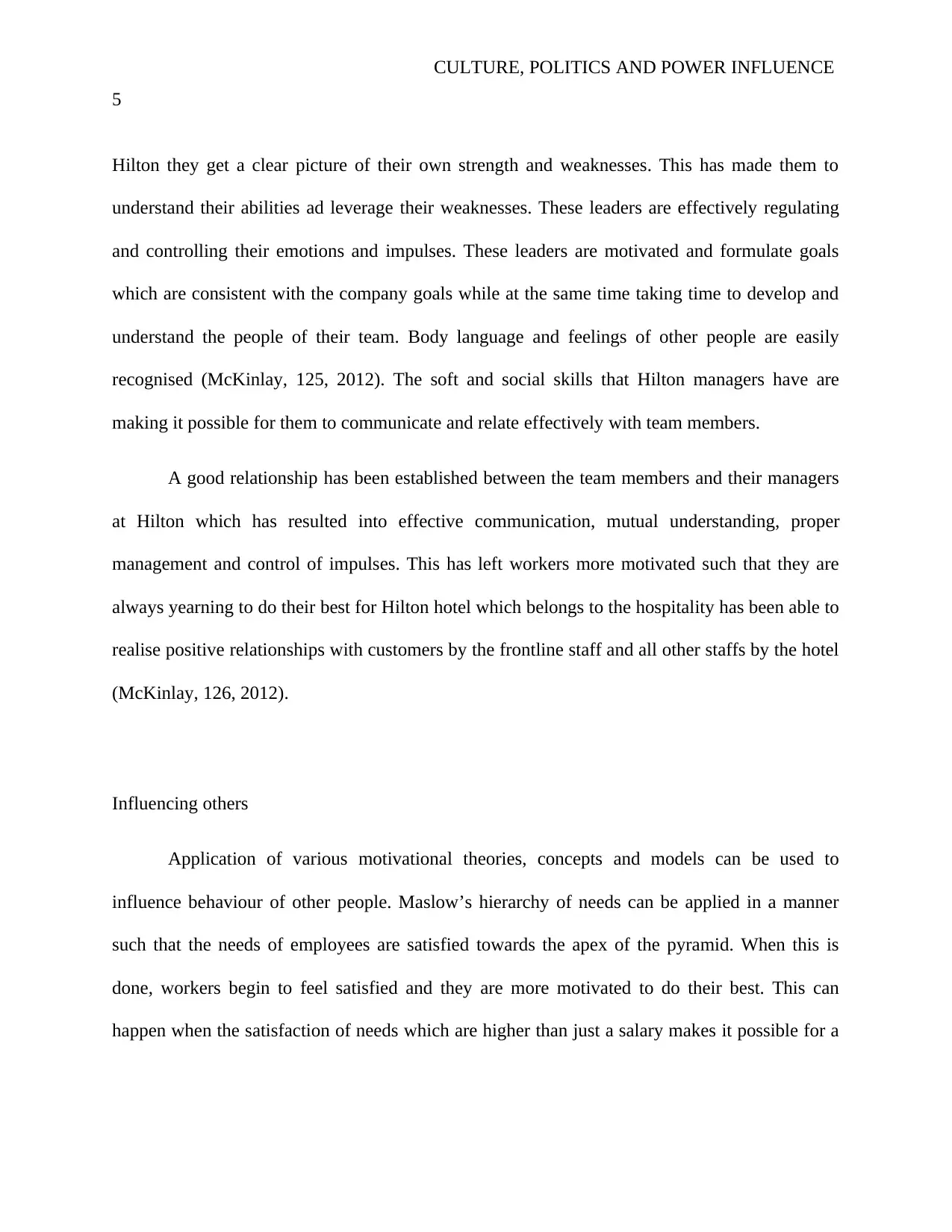
CULTURE, POLITICS AND POWER INFLUENCE
5
Hilton they get a clear picture of their own strength and weaknesses. This has made them to
understand their abilities ad leverage their weaknesses. These leaders are effectively regulating
and controlling their emotions and impulses. These leaders are motivated and formulate goals
which are consistent with the company goals while at the same time taking time to develop and
understand the people of their team. Body language and feelings of other people are easily
recognised (McKinlay, 125, 2012). The soft and social skills that Hilton managers have are
making it possible for them to communicate and relate effectively with team members.
A good relationship has been established between the team members and their managers
at Hilton which has resulted into effective communication, mutual understanding, proper
management and control of impulses. This has left workers more motivated such that they are
always yearning to do their best for Hilton hotel which belongs to the hospitality has been able to
realise positive relationships with customers by the frontline staff and all other staffs by the hotel
(McKinlay, 126, 2012).
Influencing others
Application of various motivational theories, concepts and models can be used to
influence behaviour of other people. Maslow’s hierarchy of needs can be applied in a manner
such that the needs of employees are satisfied towards the apex of the pyramid. When this is
done, workers begin to feel satisfied and they are more motivated to do their best. This can
happen when the satisfaction of needs which are higher than just a salary makes it possible for a
5
Hilton they get a clear picture of their own strength and weaknesses. This has made them to
understand their abilities ad leverage their weaknesses. These leaders are effectively regulating
and controlling their emotions and impulses. These leaders are motivated and formulate goals
which are consistent with the company goals while at the same time taking time to develop and
understand the people of their team. Body language and feelings of other people are easily
recognised (McKinlay, 125, 2012). The soft and social skills that Hilton managers have are
making it possible for them to communicate and relate effectively with team members.
A good relationship has been established between the team members and their managers
at Hilton which has resulted into effective communication, mutual understanding, proper
management and control of impulses. This has left workers more motivated such that they are
always yearning to do their best for Hilton hotel which belongs to the hospitality has been able to
realise positive relationships with customers by the frontline staff and all other staffs by the hotel
(McKinlay, 126, 2012).
Influencing others
Application of various motivational theories, concepts and models can be used to
influence behaviour of other people. Maslow’s hierarchy of needs can be applied in a manner
such that the needs of employees are satisfied towards the apex of the pyramid. When this is
done, workers begin to feel satisfied and they are more motivated to do their best. This can
happen when the satisfaction of needs which are higher than just a salary makes it possible for a
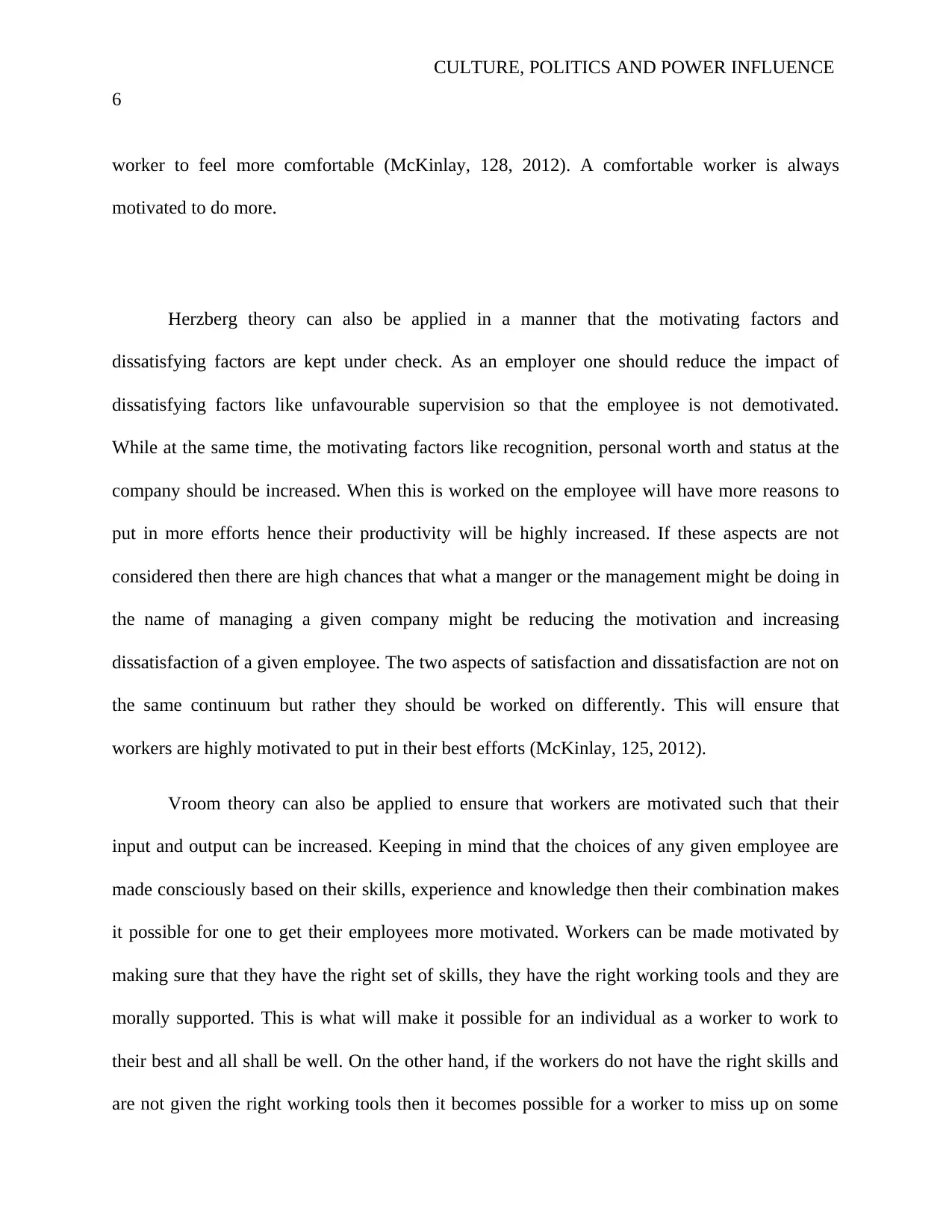
CULTURE, POLITICS AND POWER INFLUENCE
6
worker to feel more comfortable (McKinlay, 128, 2012). A comfortable worker is always
motivated to do more.
Herzberg theory can also be applied in a manner that the motivating factors and
dissatisfying factors are kept under check. As an employer one should reduce the impact of
dissatisfying factors like unfavourable supervision so that the employee is not demotivated.
While at the same time, the motivating factors like recognition, personal worth and status at the
company should be increased. When this is worked on the employee will have more reasons to
put in more efforts hence their productivity will be highly increased. If these aspects are not
considered then there are high chances that what a manger or the management might be doing in
the name of managing a given company might be reducing the motivation and increasing
dissatisfaction of a given employee. The two aspects of satisfaction and dissatisfaction are not on
the same continuum but rather they should be worked on differently. This will ensure that
workers are highly motivated to put in their best efforts (McKinlay, 125, 2012).
Vroom theory can also be applied to ensure that workers are motivated such that their
input and output can be increased. Keeping in mind that the choices of any given employee are
made consciously based on their skills, experience and knowledge then their combination makes
it possible for one to get their employees more motivated. Workers can be made motivated by
making sure that they have the right set of skills, they have the right working tools and they are
morally supported. This is what will make it possible for an individual as a worker to work to
their best and all shall be well. On the other hand, if the workers do not have the right skills and
are not given the right working tools then it becomes possible for a worker to miss up on some
6
worker to feel more comfortable (McKinlay, 128, 2012). A comfortable worker is always
motivated to do more.
Herzberg theory can also be applied in a manner that the motivating factors and
dissatisfying factors are kept under check. As an employer one should reduce the impact of
dissatisfying factors like unfavourable supervision so that the employee is not demotivated.
While at the same time, the motivating factors like recognition, personal worth and status at the
company should be increased. When this is worked on the employee will have more reasons to
put in more efforts hence their productivity will be highly increased. If these aspects are not
considered then there are high chances that what a manger or the management might be doing in
the name of managing a given company might be reducing the motivation and increasing
dissatisfaction of a given employee. The two aspects of satisfaction and dissatisfaction are not on
the same continuum but rather they should be worked on differently. This will ensure that
workers are highly motivated to put in their best efforts (McKinlay, 125, 2012).
Vroom theory can also be applied to ensure that workers are motivated such that their
input and output can be increased. Keeping in mind that the choices of any given employee are
made consciously based on their skills, experience and knowledge then their combination makes
it possible for one to get their employees more motivated. Workers can be made motivated by
making sure that they have the right set of skills, they have the right working tools and they are
morally supported. This is what will make it possible for an individual as a worker to work to
their best and all shall be well. On the other hand, if the workers do not have the right skills and
are not given the right working tools then it becomes possible for a worker to miss up on some
⊘ This is a preview!⊘
Do you want full access?
Subscribe today to unlock all pages.

Trusted by 1+ million students worldwide
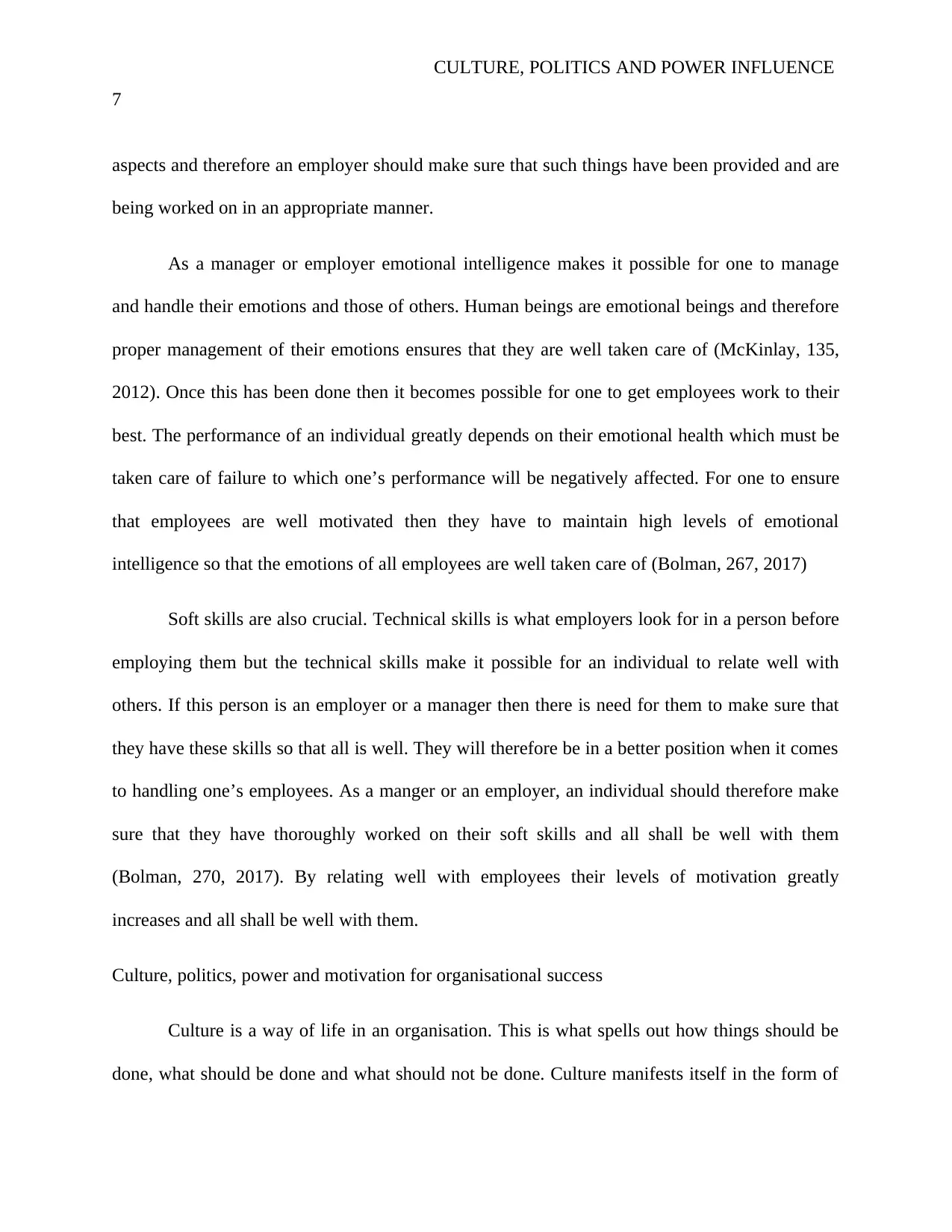
CULTURE, POLITICS AND POWER INFLUENCE
7
aspects and therefore an employer should make sure that such things have been provided and are
being worked on in an appropriate manner.
As a manager or employer emotional intelligence makes it possible for one to manage
and handle their emotions and those of others. Human beings are emotional beings and therefore
proper management of their emotions ensures that they are well taken care of (McKinlay, 135,
2012). Once this has been done then it becomes possible for one to get employees work to their
best. The performance of an individual greatly depends on their emotional health which must be
taken care of failure to which one’s performance will be negatively affected. For one to ensure
that employees are well motivated then they have to maintain high levels of emotional
intelligence so that the emotions of all employees are well taken care of (Bolman, 267, 2017)
Soft skills are also crucial. Technical skills is what employers look for in a person before
employing them but the technical skills make it possible for an individual to relate well with
others. If this person is an employer or a manager then there is need for them to make sure that
they have these skills so that all is well. They will therefore be in a better position when it comes
to handling one’s employees. As a manger or an employer, an individual should therefore make
sure that they have thoroughly worked on their soft skills and all shall be well with them
(Bolman, 270, 2017). By relating well with employees their levels of motivation greatly
increases and all shall be well with them.
Culture, politics, power and motivation for organisational success
Culture is a way of life in an organisation. This is what spells out how things should be
done, what should be done and what should not be done. Culture manifests itself in the form of
7
aspects and therefore an employer should make sure that such things have been provided and are
being worked on in an appropriate manner.
As a manager or employer emotional intelligence makes it possible for one to manage
and handle their emotions and those of others. Human beings are emotional beings and therefore
proper management of their emotions ensures that they are well taken care of (McKinlay, 135,
2012). Once this has been done then it becomes possible for one to get employees work to their
best. The performance of an individual greatly depends on their emotional health which must be
taken care of failure to which one’s performance will be negatively affected. For one to ensure
that employees are well motivated then they have to maintain high levels of emotional
intelligence so that the emotions of all employees are well taken care of (Bolman, 267, 2017)
Soft skills are also crucial. Technical skills is what employers look for in a person before
employing them but the technical skills make it possible for an individual to relate well with
others. If this person is an employer or a manager then there is need for them to make sure that
they have these skills so that all is well. They will therefore be in a better position when it comes
to handling one’s employees. As a manger or an employer, an individual should therefore make
sure that they have thoroughly worked on their soft skills and all shall be well with them
(Bolman, 270, 2017). By relating well with employees their levels of motivation greatly
increases and all shall be well with them.
Culture, politics, power and motivation for organisational success
Culture is a way of life in an organisation. This is what spells out how things should be
done, what should be done and what should not be done. Culture manifests itself in the form of
Paraphrase This Document
Need a fresh take? Get an instant paraphrase of this document with our AI Paraphraser
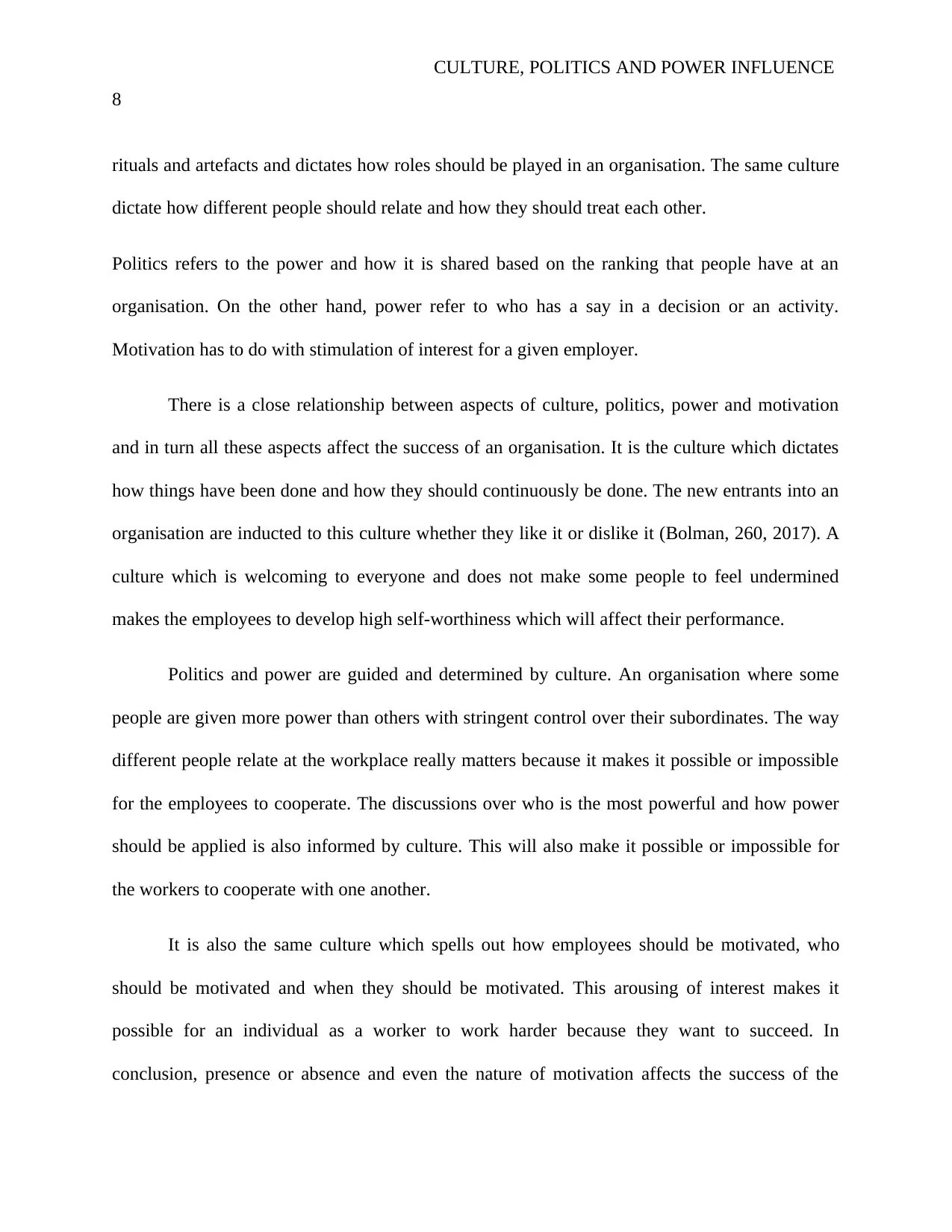
CULTURE, POLITICS AND POWER INFLUENCE
8
rituals and artefacts and dictates how roles should be played in an organisation. The same culture
dictate how different people should relate and how they should treat each other.
Politics refers to the power and how it is shared based on the ranking that people have at an
organisation. On the other hand, power refer to who has a say in a decision or an activity.
Motivation has to do with stimulation of interest for a given employer.
There is a close relationship between aspects of culture, politics, power and motivation
and in turn all these aspects affect the success of an organisation. It is the culture which dictates
how things have been done and how they should continuously be done. The new entrants into an
organisation are inducted to this culture whether they like it or dislike it (Bolman, 260, 2017). A
culture which is welcoming to everyone and does not make some people to feel undermined
makes the employees to develop high self-worthiness which will affect their performance.
Politics and power are guided and determined by culture. An organisation where some
people are given more power than others with stringent control over their subordinates. The way
different people relate at the workplace really matters because it makes it possible or impossible
for the employees to cooperate. The discussions over who is the most powerful and how power
should be applied is also informed by culture. This will also make it possible or impossible for
the workers to cooperate with one another.
It is also the same culture which spells out how employees should be motivated, who
should be motivated and when they should be motivated. This arousing of interest makes it
possible for an individual as a worker to work harder because they want to succeed. In
conclusion, presence or absence and even the nature of motivation affects the success of the
8
rituals and artefacts and dictates how roles should be played in an organisation. The same culture
dictate how different people should relate and how they should treat each other.
Politics refers to the power and how it is shared based on the ranking that people have at an
organisation. On the other hand, power refer to who has a say in a decision or an activity.
Motivation has to do with stimulation of interest for a given employer.
There is a close relationship between aspects of culture, politics, power and motivation
and in turn all these aspects affect the success of an organisation. It is the culture which dictates
how things have been done and how they should continuously be done. The new entrants into an
organisation are inducted to this culture whether they like it or dislike it (Bolman, 260, 2017). A
culture which is welcoming to everyone and does not make some people to feel undermined
makes the employees to develop high self-worthiness which will affect their performance.
Politics and power are guided and determined by culture. An organisation where some
people are given more power than others with stringent control over their subordinates. The way
different people relate at the workplace really matters because it makes it possible or impossible
for the employees to cooperate. The discussions over who is the most powerful and how power
should be applied is also informed by culture. This will also make it possible or impossible for
the workers to cooperate with one another.
It is also the same culture which spells out how employees should be motivated, who
should be motivated and when they should be motivated. This arousing of interest makes it
possible for an individual as a worker to work harder because they want to succeed. In
conclusion, presence or absence and even the nature of motivation affects the success of the
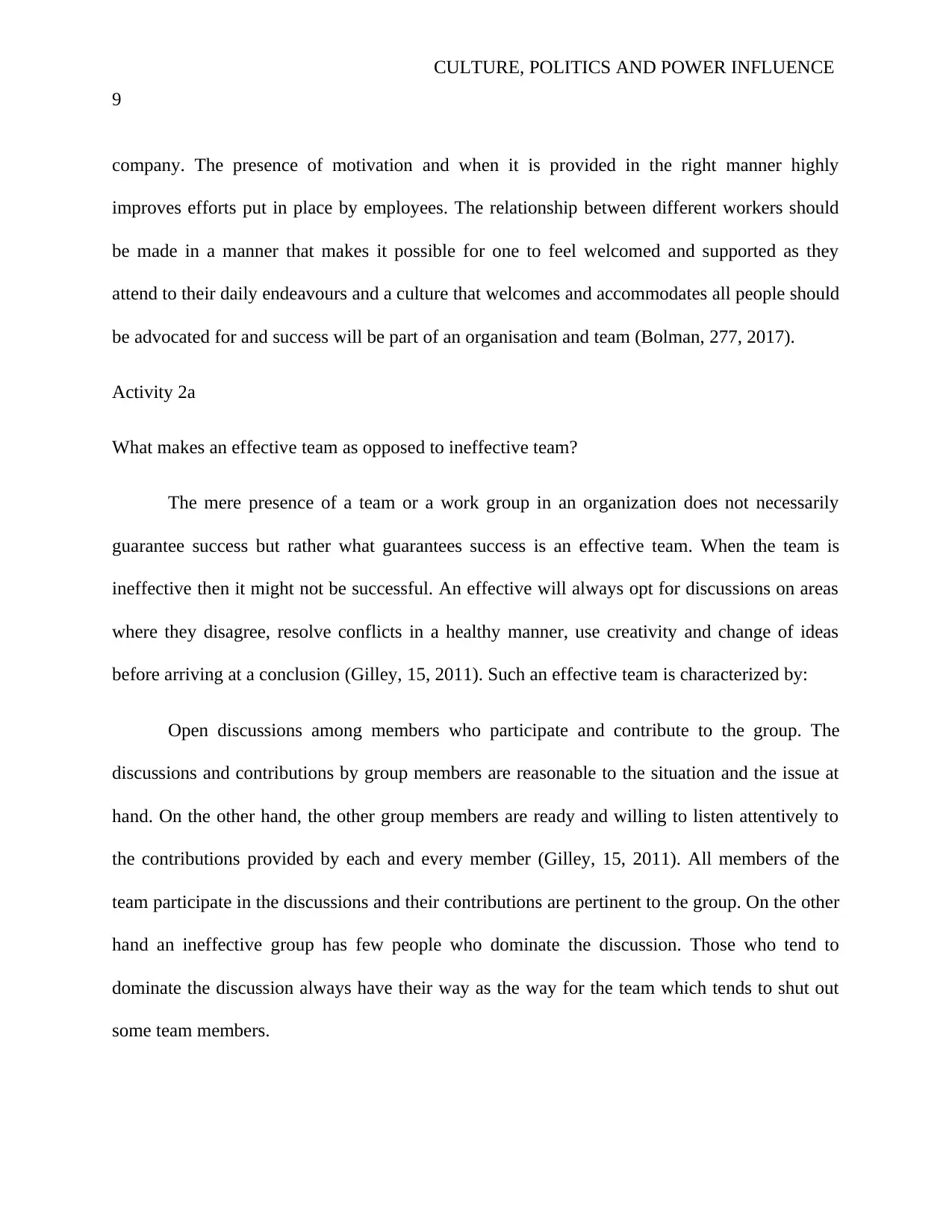
CULTURE, POLITICS AND POWER INFLUENCE
9
company. The presence of motivation and when it is provided in the right manner highly
improves efforts put in place by employees. The relationship between different workers should
be made in a manner that makes it possible for one to feel welcomed and supported as they
attend to their daily endeavours and a culture that welcomes and accommodates all people should
be advocated for and success will be part of an organisation and team (Bolman, 277, 2017).
Activity 2a
What makes an effective team as opposed to ineffective team?
The mere presence of a team or a work group in an organization does not necessarily
guarantee success but rather what guarantees success is an effective team. When the team is
ineffective then it might not be successful. An effective will always opt for discussions on areas
where they disagree, resolve conflicts in a healthy manner, use creativity and change of ideas
before arriving at a conclusion (Gilley, 15, 2011). Such an effective team is characterized by:
Open discussions among members who participate and contribute to the group. The
discussions and contributions by group members are reasonable to the situation and the issue at
hand. On the other hand, the other group members are ready and willing to listen attentively to
the contributions provided by each and every member (Gilley, 15, 2011). All members of the
team participate in the discussions and their contributions are pertinent to the group. On the other
hand an ineffective group has few people who dominate the discussion. Those who tend to
dominate the discussion always have their way as the way for the team which tends to shut out
some team members.
9
company. The presence of motivation and when it is provided in the right manner highly
improves efforts put in place by employees. The relationship between different workers should
be made in a manner that makes it possible for one to feel welcomed and supported as they
attend to their daily endeavours and a culture that welcomes and accommodates all people should
be advocated for and success will be part of an organisation and team (Bolman, 277, 2017).
Activity 2a
What makes an effective team as opposed to ineffective team?
The mere presence of a team or a work group in an organization does not necessarily
guarantee success but rather what guarantees success is an effective team. When the team is
ineffective then it might not be successful. An effective will always opt for discussions on areas
where they disagree, resolve conflicts in a healthy manner, use creativity and change of ideas
before arriving at a conclusion (Gilley, 15, 2011). Such an effective team is characterized by:
Open discussions among members who participate and contribute to the group. The
discussions and contributions by group members are reasonable to the situation and the issue at
hand. On the other hand, the other group members are ready and willing to listen attentively to
the contributions provided by each and every member (Gilley, 15, 2011). All members of the
team participate in the discussions and their contributions are pertinent to the group. On the other
hand an ineffective group has few people who dominate the discussion. Those who tend to
dominate the discussion always have their way as the way for the team which tends to shut out
some team members.
⊘ This is a preview!⊘
Do you want full access?
Subscribe today to unlock all pages.

Trusted by 1+ million students worldwide
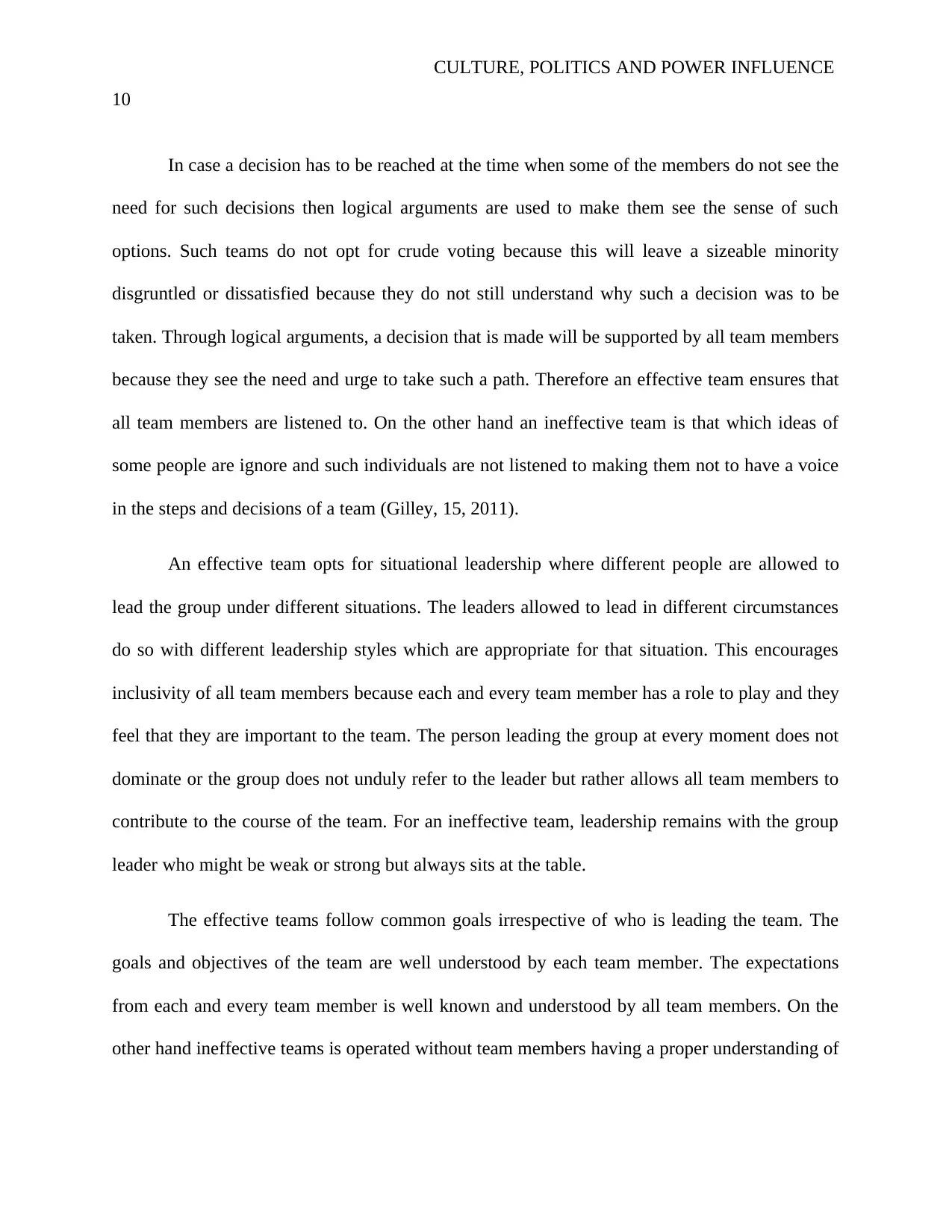
CULTURE, POLITICS AND POWER INFLUENCE
10
In case a decision has to be reached at the time when some of the members do not see the
need for such decisions then logical arguments are used to make them see the sense of such
options. Such teams do not opt for crude voting because this will leave a sizeable minority
disgruntled or dissatisfied because they do not still understand why such a decision was to be
taken. Through logical arguments, a decision that is made will be supported by all team members
because they see the need and urge to take such a path. Therefore an effective team ensures that
all team members are listened to. On the other hand an ineffective team is that which ideas of
some people are ignore and such individuals are not listened to making them not to have a voice
in the steps and decisions of a team (Gilley, 15, 2011).
An effective team opts for situational leadership where different people are allowed to
lead the group under different situations. The leaders allowed to lead in different circumstances
do so with different leadership styles which are appropriate for that situation. This encourages
inclusivity of all team members because each and every team member has a role to play and they
feel that they are important to the team. The person leading the group at every moment does not
dominate or the group does not unduly refer to the leader but rather allows all team members to
contribute to the course of the team. For an ineffective team, leadership remains with the group
leader who might be weak or strong but always sits at the table.
The effective teams follow common goals irrespective of who is leading the team. The
goals and objectives of the team are well understood by each team member. The expectations
from each and every team member is well known and understood by all team members. On the
other hand ineffective teams is operated without team members having a proper understanding of
10
In case a decision has to be reached at the time when some of the members do not see the
need for such decisions then logical arguments are used to make them see the sense of such
options. Such teams do not opt for crude voting because this will leave a sizeable minority
disgruntled or dissatisfied because they do not still understand why such a decision was to be
taken. Through logical arguments, a decision that is made will be supported by all team members
because they see the need and urge to take such a path. Therefore an effective team ensures that
all team members are listened to. On the other hand an ineffective team is that which ideas of
some people are ignore and such individuals are not listened to making them not to have a voice
in the steps and decisions of a team (Gilley, 15, 2011).
An effective team opts for situational leadership where different people are allowed to
lead the group under different situations. The leaders allowed to lead in different circumstances
do so with different leadership styles which are appropriate for that situation. This encourages
inclusivity of all team members because each and every team member has a role to play and they
feel that they are important to the team. The person leading the group at every moment does not
dominate or the group does not unduly refer to the leader but rather allows all team members to
contribute to the course of the team. For an ineffective team, leadership remains with the group
leader who might be weak or strong but always sits at the table.
The effective teams follow common goals irrespective of who is leading the team. The
goals and objectives of the team are well understood by each team member. The expectations
from each and every team member is well known and understood by all team members. On the
other hand ineffective teams is operated without team members having a proper understanding of
Paraphrase This Document
Need a fresh take? Get an instant paraphrase of this document with our AI Paraphraser
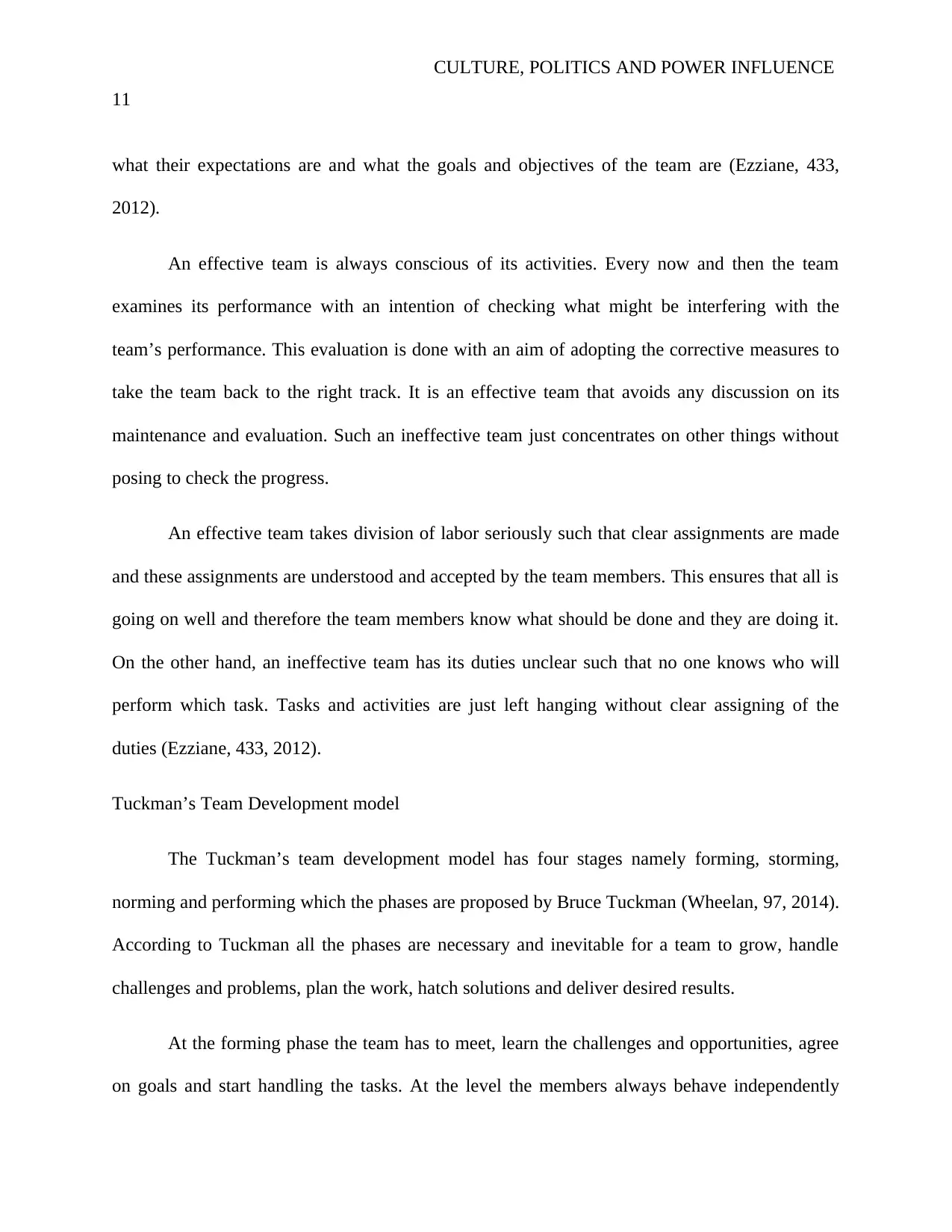
CULTURE, POLITICS AND POWER INFLUENCE
11
what their expectations are and what the goals and objectives of the team are (Ezziane, 433,
2012).
An effective team is always conscious of its activities. Every now and then the team
examines its performance with an intention of checking what might be interfering with the
team’s performance. This evaluation is done with an aim of adopting the corrective measures to
take the team back to the right track. It is an effective team that avoids any discussion on its
maintenance and evaluation. Such an ineffective team just concentrates on other things without
posing to check the progress.
An effective team takes division of labor seriously such that clear assignments are made
and these assignments are understood and accepted by the team members. This ensures that all is
going on well and therefore the team members know what should be done and they are doing it.
On the other hand, an ineffective team has its duties unclear such that no one knows who will
perform which task. Tasks and activities are just left hanging without clear assigning of the
duties (Ezziane, 433, 2012).
Tuckman’s Team Development model
The Tuckman’s team development model has four stages namely forming, storming,
norming and performing which the phases are proposed by Bruce Tuckman (Wheelan, 97, 2014).
According to Tuckman all the phases are necessary and inevitable for a team to grow, handle
challenges and problems, plan the work, hatch solutions and deliver desired results.
At the forming phase the team has to meet, learn the challenges and opportunities, agree
on goals and start handling the tasks. At the level the members always behave independently
11
what their expectations are and what the goals and objectives of the team are (Ezziane, 433,
2012).
An effective team is always conscious of its activities. Every now and then the team
examines its performance with an intention of checking what might be interfering with the
team’s performance. This evaluation is done with an aim of adopting the corrective measures to
take the team back to the right track. It is an effective team that avoids any discussion on its
maintenance and evaluation. Such an ineffective team just concentrates on other things without
posing to check the progress.
An effective team takes division of labor seriously such that clear assignments are made
and these assignments are understood and accepted by the team members. This ensures that all is
going on well and therefore the team members know what should be done and they are doing it.
On the other hand, an ineffective team has its duties unclear such that no one knows who will
perform which task. Tasks and activities are just left hanging without clear assigning of the
duties (Ezziane, 433, 2012).
Tuckman’s Team Development model
The Tuckman’s team development model has four stages namely forming, storming,
norming and performing which the phases are proposed by Bruce Tuckman (Wheelan, 97, 2014).
According to Tuckman all the phases are necessary and inevitable for a team to grow, handle
challenges and problems, plan the work, hatch solutions and deliver desired results.
At the forming phase the team has to meet, learn the challenges and opportunities, agree
on goals and start handling the tasks. At the level the members always behave independently
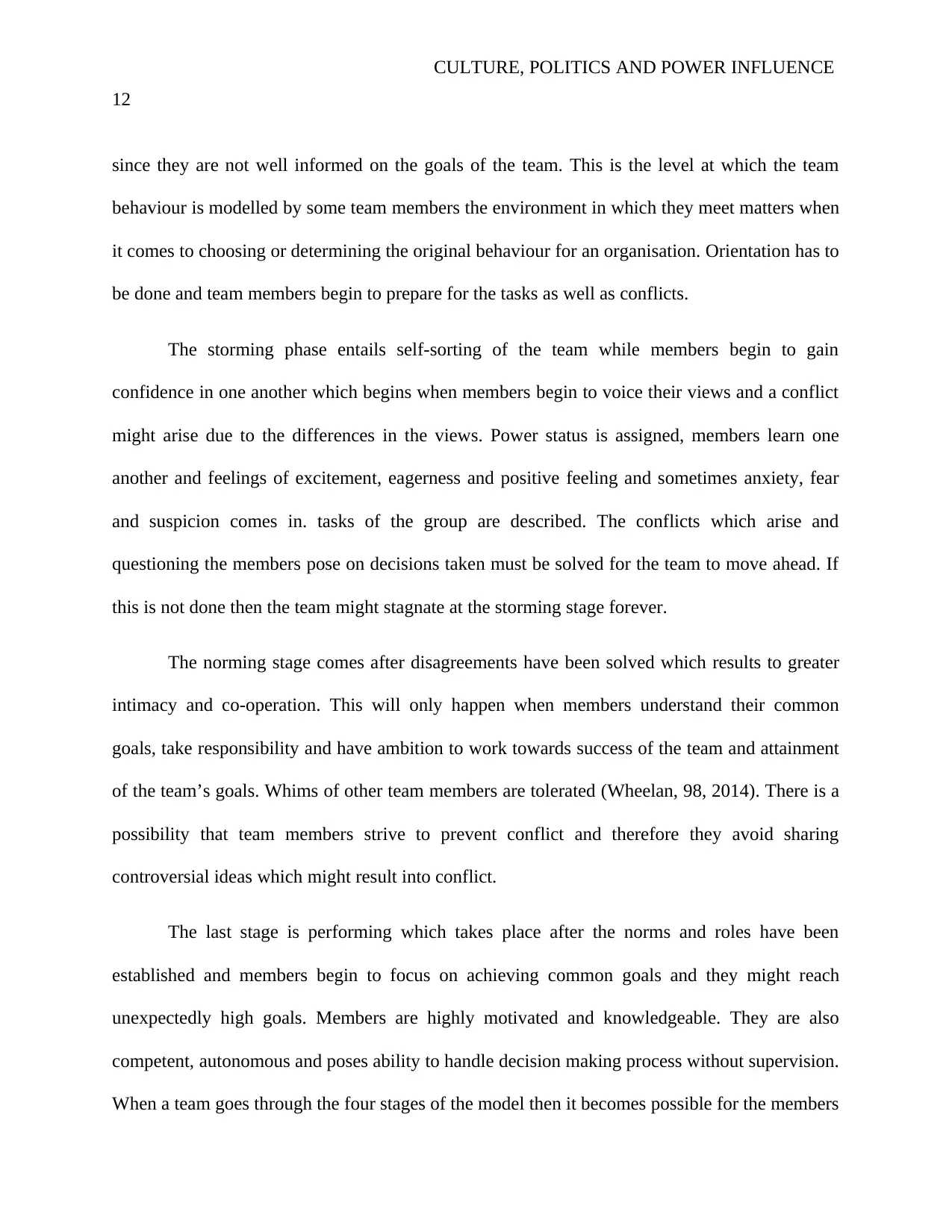
CULTURE, POLITICS AND POWER INFLUENCE
12
since they are not well informed on the goals of the team. This is the level at which the team
behaviour is modelled by some team members the environment in which they meet matters when
it comes to choosing or determining the original behaviour for an organisation. Orientation has to
be done and team members begin to prepare for the tasks as well as conflicts.
The storming phase entails self-sorting of the team while members begin to gain
confidence in one another which begins when members begin to voice their views and a conflict
might arise due to the differences in the views. Power status is assigned, members learn one
another and feelings of excitement, eagerness and positive feeling and sometimes anxiety, fear
and suspicion comes in. tasks of the group are described. The conflicts which arise and
questioning the members pose on decisions taken must be solved for the team to move ahead. If
this is not done then the team might stagnate at the storming stage forever.
The norming stage comes after disagreements have been solved which results to greater
intimacy and co-operation. This will only happen when members understand their common
goals, take responsibility and have ambition to work towards success of the team and attainment
of the team’s goals. Whims of other team members are tolerated (Wheelan, 98, 2014). There is a
possibility that team members strive to prevent conflict and therefore they avoid sharing
controversial ideas which might result into conflict.
The last stage is performing which takes place after the norms and roles have been
established and members begin to focus on achieving common goals and they might reach
unexpectedly high goals. Members are highly motivated and knowledgeable. They are also
competent, autonomous and poses ability to handle decision making process without supervision.
When a team goes through the four stages of the model then it becomes possible for the members
12
since they are not well informed on the goals of the team. This is the level at which the team
behaviour is modelled by some team members the environment in which they meet matters when
it comes to choosing or determining the original behaviour for an organisation. Orientation has to
be done and team members begin to prepare for the tasks as well as conflicts.
The storming phase entails self-sorting of the team while members begin to gain
confidence in one another which begins when members begin to voice their views and a conflict
might arise due to the differences in the views. Power status is assigned, members learn one
another and feelings of excitement, eagerness and positive feeling and sometimes anxiety, fear
and suspicion comes in. tasks of the group are described. The conflicts which arise and
questioning the members pose on decisions taken must be solved for the team to move ahead. If
this is not done then the team might stagnate at the storming stage forever.
The norming stage comes after disagreements have been solved which results to greater
intimacy and co-operation. This will only happen when members understand their common
goals, take responsibility and have ambition to work towards success of the team and attainment
of the team’s goals. Whims of other team members are tolerated (Wheelan, 98, 2014). There is a
possibility that team members strive to prevent conflict and therefore they avoid sharing
controversial ideas which might result into conflict.
The last stage is performing which takes place after the norms and roles have been
established and members begin to focus on achieving common goals and they might reach
unexpectedly high goals. Members are highly motivated and knowledgeable. They are also
competent, autonomous and poses ability to handle decision making process without supervision.
When a team goes through the four stages of the model then it becomes possible for the members
⊘ This is a preview!⊘
Do you want full access?
Subscribe today to unlock all pages.

Trusted by 1+ million students worldwide
1 out of 20
Your All-in-One AI-Powered Toolkit for Academic Success.
+13062052269
info@desklib.com
Available 24*7 on WhatsApp / Email
![[object Object]](/_next/static/media/star-bottom.7253800d.svg)
Unlock your academic potential
Copyright © 2020–2025 A2Z Services. All Rights Reserved. Developed and managed by ZUCOL.
